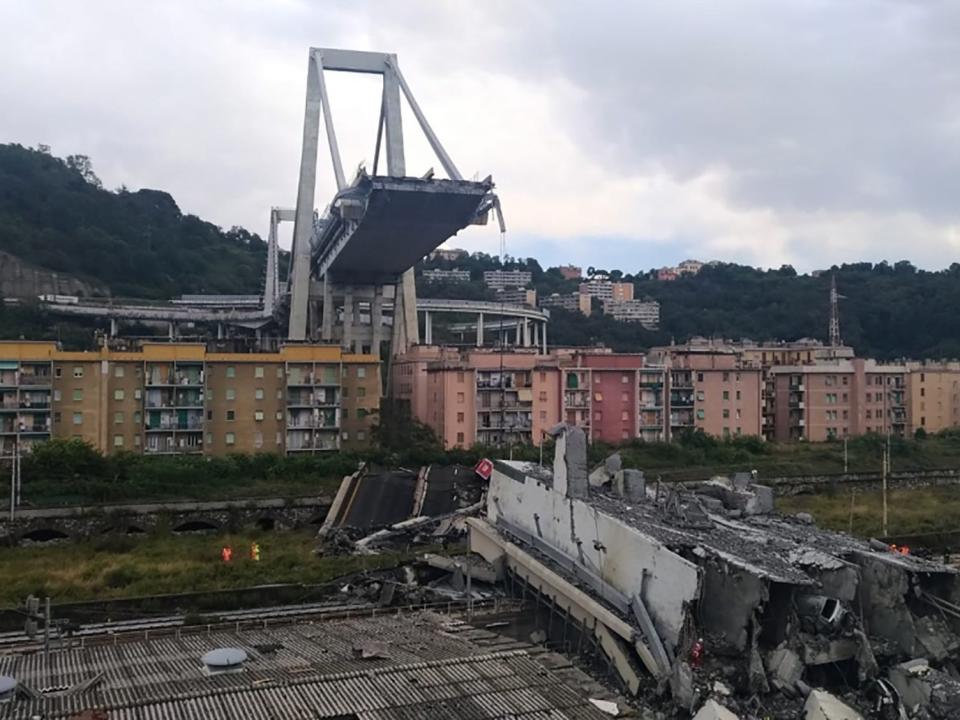Genoa bridge collapse: Hundreds evacuated from surrounding homes amid panic over remaining sections of structure
At least 630 people have been evacuated from homes near the major motorway bridge which collapsed in Genoa, northern Italy, over fears about the stability of remaining sections of the structure.
Around 1,000 rescue workers continued to search for survivors among towering slabs of concrete and twisted steel after part of the Morandi Bridge plunged around 45 metres, killing 39 people on the eve of Italy’s biggest summer holiday.
Italy’s interior minister, Matteo Salvini, declined to say how many people might still be buried in the debris, and said trying to locate them was particularly difficult due to the holiday.
“It’s not easy to distinguish between who don’t respond because they are on the other side of the world and turned off their phone to relax on vacation, and who’s not responding because they are under the rubble,” he said.
He said he hoped the death toll would not rise. “Miracles are still possible,” Mr Salvini added.
Politicians have squabbled over who to blame, with Italy’s deputy prime minister, Luigi Di Maio, saying the state will have to take over the country’s motorways if companies who have concessions are not able to do the job properly.
Speaking on Italian radio two days after the collapse, he also said the concessionary should have invested more in security instead of being concerned about dividends.
Authorities have called for the quick removal of tons of debris from a dry river bed so the rubble doesn’t create a makeshift dam if heavy rains fall in the flood-prone city.
Debris must also be cleared from railroard tracks, a vital link especially now Genoa is largely cut in half by the loss of such a key artery, the Italian prime minister, Giuseppe Conte said.
Concerns over the stability of remaining large sections of the bridge prompted a wider evacuation order from nearby apartments, some of which are practically in the shadow of the elevated motorway. Firefighters went inside some of the vacated apartments briefly to retrieve documents and, in at least one home, pet cats.
After leading an emergency cabinet meeting in Genoa, Mr Conte said there were 39 confirmed dead and 16 injured, including nine in serious condition. Three children were among those killed, Mr Salvini said.
The dead included four French citizens travelling to a music festival and two Albanians.
The 50-year-old Morandi Bridge, named after the engineer who designed it, is part of a toll motorway run by Autostrade per l’Italia linking the port city of Genoa with southern France and Milan.
Genoa prosecutor Francesco Cozzi told reporters the investigation into the collapse was focused on human causes, specifically any possible design flaws in the bridge’s construction or any inadequate maintenance.
He said he didn’t know who might be responsible, but added: “It wasn’t an accident.”
Asked if authorities had any warning the bridge could be dangerous, Mr Cozzi indicated no serious safety concerns had reached his office before the collapse. Otherwise, “none of us would have driven over that highway 20 times a month, as we do”, he said.
A €20m (£18m) project to upgrade the bridge’s safety had already been approved, with public bids to be submitted by September.
One expert, Antonio Brencich at the University of Genoa, had previously called the bridge “a failure of engineering”. Other engineers, noting its age, said corrosion and decades of wear and tear from weather also could have been factors in the collapse.
Mr Conte said the government wouldn’t wait until the investigation was completed to revoke the concession Autostrade per l’Italia, which operates many of the nation’s toll motorways. The next company would be held to “more stringent” rules for maintenance, he said.
Mr Di Maio, of the anti-business Five Star Movement, alleged Autostrade’s holding company took profits “instead of investing money for maintenance.”
Mr Toninelli, the transportation and infrastructure minister and another populist Five Star leader, said his ministry had started procedures so Autostrade could be fined up to €150m.
It emerged the governing populist party wrote off safety fears about the bridge as a children’s “fairy story,” with a statement on the Five Star Movement’s website in 2013 describing warnings of “the imminent collapse of the Morandi Bridge” as a “favoletta”, or children’s fairytale.
Additional reporting by agencies

 Yahoo News
Yahoo News 

